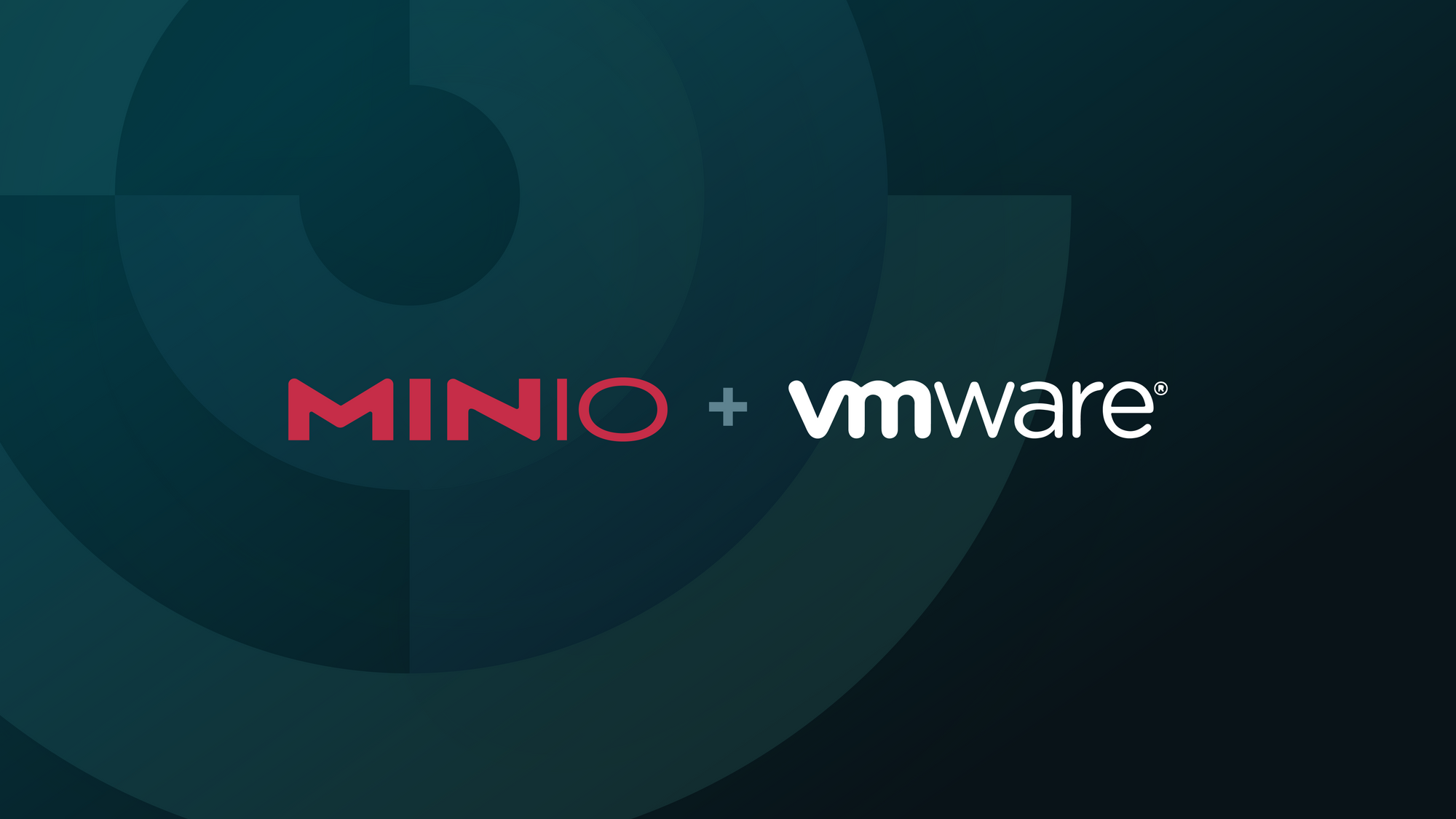Come and Get It...MinIO + VMware GA with VCF 4.2

Several months ago, we announced that we were among a handful of design partners selected to work with VMware on their VMware vSAN™ Data Persistence platform. That announcement was an expansion of our existing partnership which had focused on cloud pioneer Pivotal.
The announcement in September was different, however, in that it brought us into heart of VMware with vSphere and vCenter integration.
What was lacking, and what we announce today is the general availability of VMware Cloud Foundation 4.2 (VCF) with Tanzu. VCF is the right vehicle for enterprises looking to roll out the powerful new features in the Data Persistence platform as it streamlines key elements while it abstracts others.
As we noted in our last post, at the most basic level, this new integration builds a bridge into each other’s respective worlds.
By adding MinIO’s object storage to the vSAN Data Persistence platform we bring them into our cloud-native ecosystem bringing them thousands of cloud-native applications that depend on MinIO for their data infrastructure.
VMware, in turn, brings us into the Enterprise IT ecosystem - an ecosystem they dominate. They invented an entire category with virtualization and built it into a multi-billion dollar industry. Extending this success into Kubernetes ensures that they defend their “birthright” while bringing IT into the cloud-native world.
The implications of today’s announcement go beyond the general availability they impact VMware’s customer base broadly over the coming quarters. To be fair, not every customer is on Cloud Foundation today, but that will change in 2021 as more customers understand the power of what it offers.
Together, however, MinIO and VMware bring the following value to the market with this VCF GA announcement:
The hybrid-cloud.
VMware has a goal of letting enterprises build, run, manage, connect, and protect any app on any cloud and across clouds. It is an increasingly competitive market.
To be successful, it will be more than just ad campaigns and marketing slogans. VMware must be able to deliver consistency with regard to the infrastructure, operations and developer experiences. This is where MinIO plays an outsized role.
Public clouds are incompatible with regard to the storage layer. GCS, Azure, AWS all speak different APIs. The problem is compounded on the private cloud where HDFS, NFS, SMB, iSCSI, FC and a laundry list of other protocols exist.
MinIO provides a complete cloud-native object storage system that can be deployed on any cloud infrastructure to convert them into an S3 compatible object storage service. With 10.5M IPs in AWS, GCP and Azure today - we can more than prove our claim.
Further, MinIO can also provide seamless interoperability to existing storage systems. The result is that applications can access data on their existing legacy systems without migrating the data over. Both cloud-native applications and traditional enterprise applications can co-exist - creating a roadmap for the eventual migration to 100% cloud native.
VMware and MinIO are uniquely suited to deliver against this ambition. It is one of the key reasons that MinIO selected us to be their design partner. The hybrid cloud is the future and we give them the best chance of winning it.
Related: VMware Object Storage Solutions & Integration
Bringing cloud native applications onto VMware.
MinIO provides a massive portfolio of cloud native applications to the vSAN Data Persistence platform. Any application that runs on MinIO (which is to say almost every cloud native application) now runs unmodified on the vSAN Data Persistence platform - starting on day one. Harbor, Velero, Prometheus, Grafana, Spinnaker, Keras, Spark, Presto/Starburst, Influxdb, Fluend, Flume. Day one. Pick your favorite cloud native application, plug it into Google, add MinIO. Odds are that you will find documentation, tutorials or a Medium post. That application - day one.
Performance to deliver the widest range of applications.
While MinIO brings a suite of cloud native applications to VMware on day one, not every application was born in the cloud. Many weren’t and while they will migrate towards that goal over time - the truth is that Splunk, databases or other “traditional” applications want to run in on the DPp too. For that to happen, they require performance. Not traditional object storage performance which is designed for archival use cases but modern object storage designed for throughput oriented use cases. MinIO has built its reputation as the world’s fastest object store. It is why we are attractive to so many applications from AI/ML to modern, data intensive cloud apps.
Because the vSAN-Direct architecture provides direct access to the underlying drives in JBOD/F mode and delegates core storage functions to us (erasure coding, bit-rot protection, encryption key management), we can run at full speed. vSAN-Direct focuses on the physical to virtual block layer management such as provisioning, isolation, capacity management and failure handling.
The result is a win-win-win. Win for VMware as more applications will find the Tanzu platform attractive. Win for MinIO as we don’t trade any applications in the acquisition of the IT market. Win for application developers and IT as they are finally on the same page, speaking the same language.
Software for a software world.
With the vSAN Data Persistence platform VMware offers true software defined storage experiences for applications running on Kubernetes. This allows MinIO to bring their Kubernetes-native object storage as a Tanzu integrated service.
Given that MinIO was always software-defined, it is seamless to deploy as a containerized offering. vSAN and MinIO together help accelerate the digital transformation for companies by giving a uniform true cloud experience for developers writing the next generation of applications.
There will be other companies that come onto the platform over time. Most of them will come from a hardware appliance background. Software is a DNA thing. We like our chances to be the default choice for object storage. .
Conclusion
The net of this is MinIO is an important part of VMware’s Kubernetes architecture. While the vision is expansive, MinIO is able to bring distinct capabilities and functionality to the vSAN Data Persistence platform ecosystem. The result is performant, persistent storage and a host of cloud native applications that will be turnkey for VMware’s partners and customers.
More importantly - now is the time to move into serious testing. The code is released. Users can provision MinIO automatically from the vCenter interface. The first 60 days are under a free trial - after that a license key is needed. If you specific questions with regards to your requirements please contact us at vmware@min.io
Every license key comes with a full commercial license to MinIO and full access to the MinIO Subscription Network (SUBNET). SUBNET offers 24/7/365 direct to engineer support, access to the panic button, architecture and security reviews and all of the SUBNET health diagnostic capabilities. There is no limit on the number of issues that can be logged, nor the number of seats afforded to the organization. Pricing is based on capacity and can be billed at any time.
Want to go deeper? Hit the ask the expert prompt and speak to the team.






